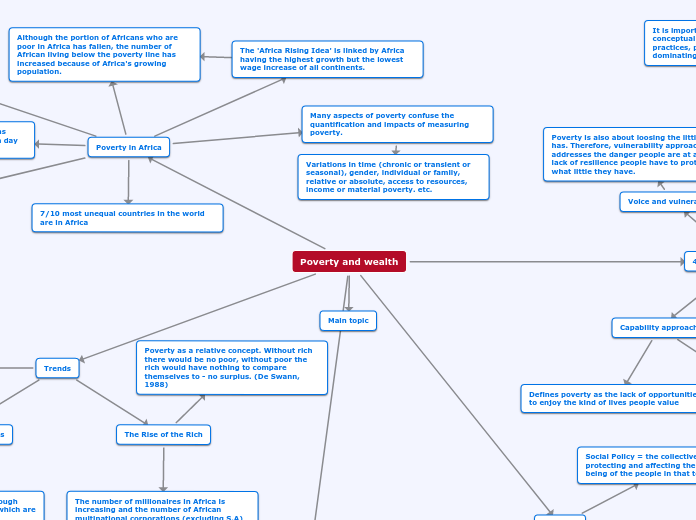Poverty and wealth
Poverty in Africa
7/10 most unequal countries in the world are in Africa
Poverty line set by the World bank was increased from $1.25 a day to $1.90 a day in 2015, using PPP
Although the portion of Africans who are poor in Africa has fallen, the number of African living below the poverty line has increased because of Africa's growing population.
The 'Africa Rising Idea' is linked by Africa having the highest growth but the lowest wage increase of all continents.
Many aspects of poverty confuse the quantification and impacts of measuring poverty.
Variations in time (chronic or transient or seasonal), gender, individual or family, relative or absolute, access to resources, income or material poverty. etc.
Conceptualising poverty can be done either through poverty as a state of affairs or as a process.
As a state of affairs poverty is occurs for who, when, where and how many.
As a process, poverty occurs why and how?
In summary, poverty should not be considered as homogenous, there are two was of thinking about poverty as an idea and Africa rising is confusing.
4 Approaches to Poverty
Capability approach
Defines poverty as the lack of opportunities to enjoy the kind of lives people value
Amartya Sen
Monetary approach
An alternative approach to monetary - in terms of indicators - is the MPI. It uses 10 indicators of 3 different categories (health, standard of living, education) to gauge the multidimensional phenomenal of poverty.
Has the misleading aspect of appearing the most objective and empirical measure of poverty, when certain decisions have been pre-made to define poverty and methodologies are not accurate. For this reason people tend to assume the other three approached to poverty are more subjective and less fact based.
Social Exclusion
Focusses on the processes which lead to deprivation within society. Philosophical side as it questions the mandate of the state to protect its citizens
Voice and vulnerability
Poverty is also about loosing the little one has. Therefore, vulnerability approach addresses the danger people are at and the lack of resilience people have to protect what little they have.
Subtopic
It is important to be aware of the conceptual apparatus underlying different practices, particularly in the case of the dominating paradigm of monetary policy.
A broader characterisation of poverty should be adopted when identifying and targeting the poor in the development discourse.
Trends
The Rise of the Middle Class
How is middle class measured? through new types of products consumed (which are getting cheaper to buy) or through changing social status? changing employment type?
The Rise of the Rich
The number of millionaires in Africa is increasing and the number of African multinational corporations (excluding S.A) are also increasing by spreading into more countries.
Poverty as a relative concept. Without rich there would be no poor, without poor the rich would have nothing to compare themselves to - no surplus. (De Swann, 1988)
Centrality of Gender
Women in Cameroon are restricted by landowning rights, confining them to poverty. But when given land rights to grow rice paddies themselves significant social and political ramifications prevented the intervention from lifting these women out of poverty.
Critiques
Mkandawire (2010) critiques the neglect of equality when solving poverty - actors typically NGO's focus on full employment instead.
unify around a technical aim instead
The interests of the poor are not central; too little state action and strategy for the poor in rural areas particularly.
Social Policy = the collective public effort at protecting and affecting the social well-being of the people in that territory.
The way to solve problems
Economic policy can also act as social policy by 1) being more effective than achieving narrowly defined policies. 2) economic policy can be a route out of policy e.g. higher employment = more opportunities. NB: unpaid work must be considered too tho. etc.
EDI - "the extreme deprivation index" uses non-food goods owned by a household to categorise poverty in rural Uganda. This is a quick way of differentiating a household in the bottom and second bottom quintile of poverty
The key point behind this is the fact that poor people often choose a less nutritious diet, sustained by low cost foods, in order to dramatically improve their quality of life. E.g. buying a bed so they don't have to sleep on the floor.
EDI has the ability to fix commitment social protection which is half hearted due to political alliance and ethnicity in Uganda as it is very much a quick fix kinda tool.
